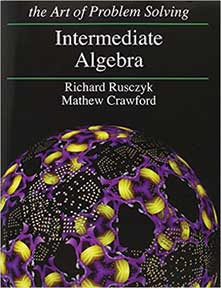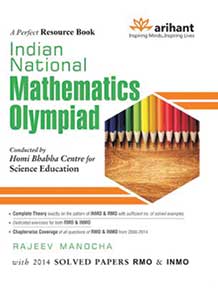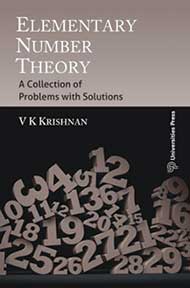Ramya Ramalingam
The mathematical Olympiads aim to test the problem solving ability and ingenuity of students at the high school level (9th to 12th standard). The topics relevant to Olympiads include geometry (including some trigonometry), algebra (including inequalities), combinatorics, and number theory but knowledge of calculus or other higher mathematics is not required. The relevant topics are generally taught in high school. However, most of these topics require a more in-depth understanding than the one fostered at school (in my experience, combinatorics is touched very briefly and number theory is not part of the syllabus at all in India). So a secure, grounded, well-founded knowledge of these topics is an essential pre-requisite for anyone who wants to do well in the Olympiads.
I have found that solving problems of the appropriate level is the best way to prepare for any math competition, and this is more so for the Olympiads than for anything else. Solving previous year question papers and problems of similar nature and difficulty is essential and allows you to get a sense of the type of questions asked and how to approach them. However, it is sometimes difficult to find problems of the right level of difficulty (for a given student) and even harder to find their solutions. The following is a list of books that I found useful in my endeavour to prepare for the Olympiads:
Level 0 (Elementary)
These books can be used by middle school students (4th to 8th grade) to get a jump start on the topics that are building blocks to problem solving techniques. They are, however, not sufficient for high school Olympiads.
E-Z Algebra and EZ – Trigonometry by Douglas Downing published by Barrons (The E-Z series) is a set of self-study books that follow an interesting story-line to pique interest in children. Each book starts off with a few trivial chapters but goes on to discuss higher topics that may not even be covered in high school. Each chapter is followed by a problem set, for which the answers (without solutions) are presented at the back.
Pre-algebra by Richard Rusczyk, David Patrick, Ravi Boppana (published by Art of Problem Solving) covers all major topics preceding algebra.
Competition Math for Middle School by Jason Batterson (published by Art of Problem Solving) has a multitude of extremely well explained examples and challenging problems at the middle school level.
Level 1 (Beginners)
These books delve into topics that are essential for Olympiads. All of the Art of Problem Solving (AoPS) books have a number of well-explained examples and a host of problems with clearly demarcated levels. Each book has an accompanying solutions manual with complete solutions for every single problem in the text. I highly recommend all of the AoPS books for anyone who wishes to improve their math understanding (at the high school level).
First steps for math Olympians by J. Douglas Faires (published by The Mathematical Association of America). This book targets the American Mathematics Competitions (AMC), and is a good, but basic, review of the relevant topics. The book is divided into various sections, each of which speaks about the important theorems in each topic. There are 3 examples and 10 problems (with solutions) in each chapter.
 Introduction to Counting & Probability by David Patrick (published by the Art of Problem Solving).
Introduction to Counting & Probability by David Patrick (published by the Art of Problem Solving).
Introduction to Geometry by Richard Rusczyk (published by the Art of Problem Solving).
Introduction to Number Theory by Mathew Crawford (published by the Art of Problem Solving).
Introduction to Algebra by Richard Rusczyk (published by the Art of Problem Solving).
The Art of Problem Solving Volume 1: the basics by Sandor Lehoczky and Richard Rusczyk
The Art of Problem Solving Volume 2: and Beyond by Richard Rusczyk and Sandor Lehoczky.
Books 9 and 10 are slightly different from the other AoPS books, in that they cover a wide range of topics, each within a few pages, while the other books go in depth on one particular topic.
Level 2 (Intermediate)
Intermediate Counting & Probability by David Patrick (published by the Art of Problem Solving).
Intermediate Algebra (published by the Art of Problem Solving).
Intermediate Number Theory (published by the Art of Problem Solving).
Challenging Problems in Algebra by Alfred S. Posamentier and Charles T.Salkind (published by Dover Publications).
Challenging Problems in Geometry by Alfred S.Posamentier and Charles T.Salkind (published by Dover Publications).
Books 14 and 15 contain only problems that are in a generally increasing order of difficulty within each chapter. The solutions are also in the book, and are well-explained, with accompanying diagrams if required.
Mathematical Circles (Russian Experience) by Dmitri Fomin, Sergey Genkin, llia ltenberg (published by Universities press).
Test of Mathematics at the 10+2 Level, by Indian Statistical Institute (published by East-West Press). This book has both multiple choice questions and long answer type questions, but they are not specifically ordered with regards to difficulty.
Level 3 (Pre-Advanced)
These books assume you have a certain amount of prowess at solving problems and knowledge of high-school concepts. Any explanations of theorems will be concise and not always detailed step-to-step.
 A Perfect Resource Book on Indian National Mathematics Olympiad by Rajeev Manocha (published by Arihant). This book targets the Indian Math Olympiads – specifically the RMO and the INMO. It is divided into sections, each of which delves into a certain mathematical topic and explains useful theorems and strategies used frequently in Olympiads. This book has plenty of solved examples and the explanations are quite clear. Each chapter ends with a large number of problems, many of which are taken from the previous year RMO and INMO papers. These questions are divided into Level 1 (roughly RMO level) and Level 2 (roughly INMO level). Many, but not all, of the problems have written solutions in the book.
A Perfect Resource Book on Indian National Mathematics Olympiad by Rajeev Manocha (published by Arihant). This book targets the Indian Math Olympiads – specifically the RMO and the INMO. It is divided into sections, each of which delves into a certain mathematical topic and explains useful theorems and strategies used frequently in Olympiads. This book has plenty of solved examples and the explanations are quite clear. Each chapter ends with a large number of problems, many of which are taken from the previous year RMO and INMO papers. These questions are divided into Level 1 (roughly RMO level) and Level 2 (roughly INMO level). Many, but not all, of the problems have written solutions in the book.
Challenge and Thrill of Pre-College Mathematics by V.Krishnamurthy, C.R.Pranesachar, K.N. This is an excellent book to practise problems from and covers a large syllabus. A couple of drawbacks are that it does not arrange problems in order of difficulty, and has answers (not even solutions) for less than half the questions.
Problem-Solving Strategies by Arthur Engel published by Springer – Arthur Engel discusses a variety of high level strategies (some of which may be too high to actually use in most Olympiads) and demonstrates their use. There are a large number of problems, some of which have hints or solutions.
Problem Primer for the Olympiad by C R Pranesachar, B J Venkatachala, C S Yogananda.
AHA Solutions by Martin Erickson (published by Mathematical Association of America).
A Gentle Introduction to the American Invitational Mathematics Exam by Scott A. Annin published by MAA Press.
Level 4 (Advanced)
Someone practicing from these books is likely to already know most important theorems and proofs, and explanations would probably only serve to reinforce these. These books have, however, a wide range of difficult and well-thought out problems of a high Olympiad level.
 Geometry Revisited by H.S.M.Coxeter and S.L.Greitzer by Mathematical Association of America.
Geometry Revisited by H.S.M.Coxeter and S.L.Greitzer by Mathematical Association of America.
Elementary Number Theory by V.K Krishnan published by Universities Press.
103 Trigonometry Problems (From the training of the USA IMO Team) published by Titu Andreescu and Zuming Feng by Springer International Edition.
Mathematical Olympiad Treasures by Titu Andrescu and Bogdan Enescu published by Springer International Edition.
Resources for Olympiad level online courses
https://www.artofproblemsolving.com/school
http://blog.cheenta.com/courses/
https://www.artofproblemsolving.com/store/online
http://www.maa.org/press/books
Resources for Olympiad level questions and answers
https://www.artofproblemsolving.com/community/c13_contests
Some of the above books may be expensive for individuals to purchase. I highly recommend and urge the school libraries to purchase and make them available for the students.
Please note that even students in India can write the American Mathematical Competition (AMC) if you can find some school willing to conduct the exam. These results may come in handy especially if you are applying abroad. Note that preparing for Olympiads is also helpful if you plan to write the entrance exams for the Indian Statistical Institute or Chennai Mathematical Institute.
The author is a class 11 student of National Public School, HSR Layout. She has cleared the Regional Mathematical Olympiad (RMO) 2015 conducted by the Indian Statistical Institute, Bangalore. She was in the honour roll of AMC-10 (2015) (American Mathematical Competition) and, based on this performance, was invited to appear in AIME (American Invitational Mathematics Examination) and the Math Prize for Girls at MIT. She is an avid reader also interested in writing, music, and basketball. She can be reached at ramalingam.ramya@gmail.com.
Related articles
Taking the challenge
A platform for problem-solving
A fateful day and an odd proof
An evolving culture
MUNning and other dress-up games
